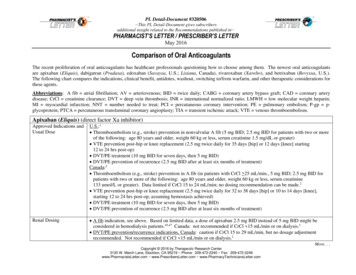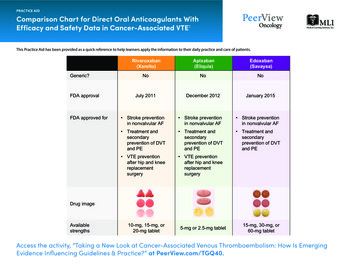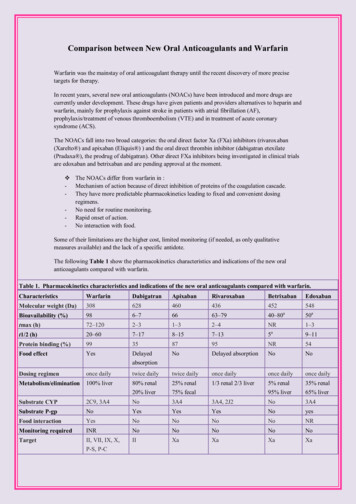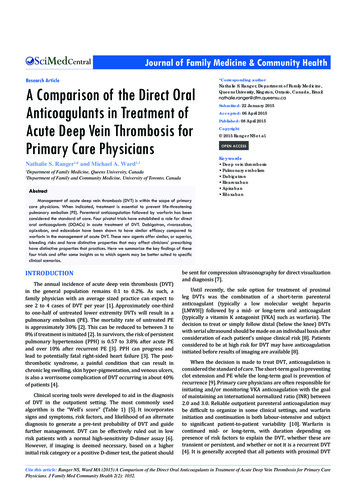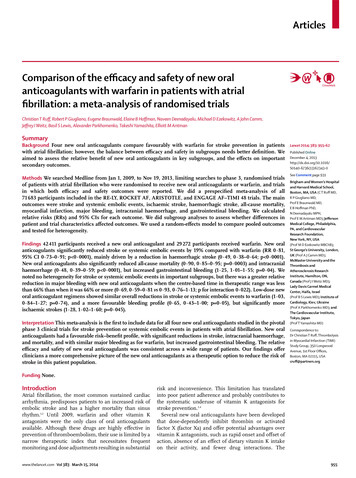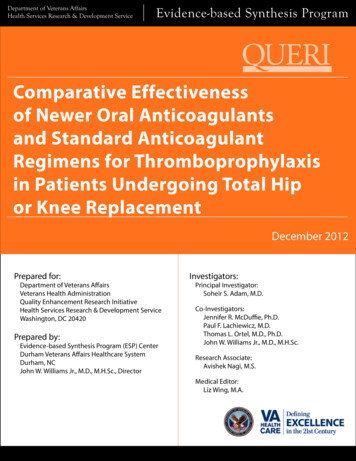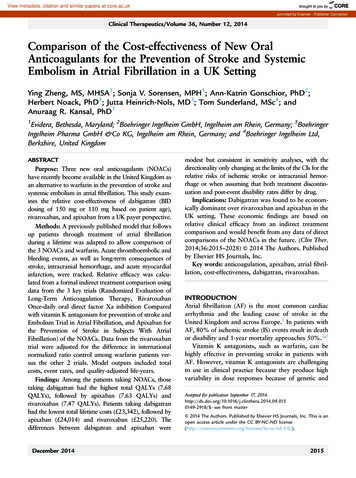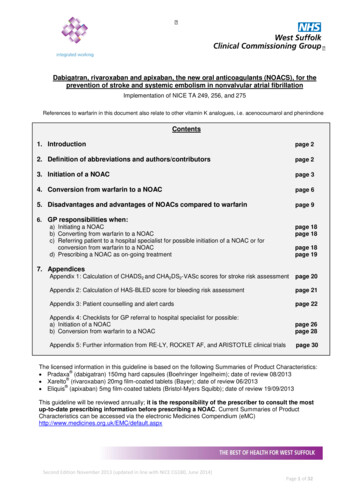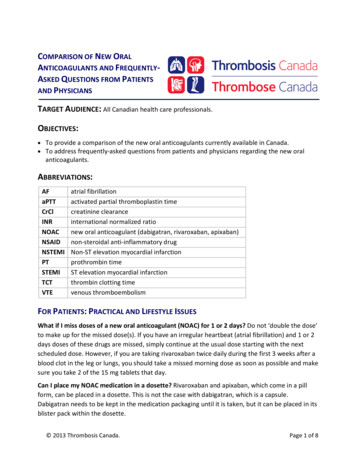
Transcription
COMPARISON OF NEW ORALANTICOAGULANTS AND FREQUENTLYASKED QUESTIONS FROM PATIENTSAND PHYSICIANSTARGET AUDIENCE: All Canadian health care professionals.OBJECTIVES: To provide a comparison of the new oral anticoagulants currently available in Canada.To address frequently-asked questions from patients and physicians regarding the new NSAIDNSTEMIPTSTEMITCTVTEatrial fibrillationactivated partial thromboplastin timecreatinine clearanceinternational normalized rationew oral anticoagulant (dabigatran, rivaroxaban, apixaban)non-steroidal anti-inflammatory drugNon-ST elevation myocardial infarctionprothrombin timeST elevation myocardial infarctionthrombin clotting timevenous thromboembolismFOR PATIENTS: PRACTICAL AND LIFESTYLE ISSUESWhat if I miss doses of a new oral anticoagulant (NOAC) for 1 or 2 days? Do not ‘double the dose’to make up for the missed dose(s). If you have an irregular heartbeat (atrial fibrillation) and 1 or 2days doses of these drugs are missed, simply continue at the usual dose starting with the nextscheduled dose. However, if you are taking rivaroxaban twice daily during the first 3 weeks after ablood clot in the leg or lungs, you should take a missed morning dose as soon as possible and makesure you take 2 of the 15 mg tablets that day.Can I place my NOAC medication in a dosette? Rivaroxaban and apixaban, which come in a pillform, can be placed in a dosette. This is not the case with dabigatran, which is a capsule.Dabigatran needs to be kept in the medication packaging until it is taken, but it can be placed in itsblister pack within the dosette. 2013 Thrombosis Canada.Page 1 of 8
Can I take my NOAC medication with meals? Dabigatran capsules should be taken with food toreduce the risk of stomach upset or can be taken with water. Rivaroxaban should be taken with ameal to enhance absorption; the pill can also be crushed and taken with soft food such asapplesauce. Apixaban can be taken with a meal but does not need to be.What if I develop heartburn or stomach upset after starting a NOAC? Many new drugs can causestomach upset. This problem occurs in up to 10% of patients who start dabigatran and is lesscommon with rivaroxaban or apixaban. Taking the medication with meals can reduce the risk ofstomach upset and the problem often improves on its own after a few days. Antacids may help iftaken 2 hours after a dabigatran dose. If the problem persists, contact your doctor.Are there any foods I need to avoid if I am taking a NOAC? Unlike with warfarin, there are noknown food interactions with NOACs, so there are no food restrictions when taking NOACs.Will grapefruit juice affect the way the NOACs work? There is no evidence that drinkinggrapefruit juice affects the efficacy or safety of NOACs.Can I consume alcoholic beverages if I am taking a NOAC? In general, it is acceptable to have aglass of wine or beer with a meal when taking a NOAC (or when taking warfarin).FOR PATIENTS: NOACS AND OTHER MEDICATIONSCan I take Tylenol or drugs such as Advil if I am taking a NOAC? In general, long-term use of aNOAC combined with a non-steroidal anti-inflammatory drug (NSAID) such as Advil (ibuprofen)should be avoided. However, it is probably safe to combine a NOAC with an NSAID for short, 3-5day periods, for example, to treat acute joint pain. Tylenol (acetaminophen) is preferred over anNSAID for joint pain, headache or if you have cold or flu-like symptoms. If there is a need forlonger periods of treatment with an NSAID or acetaminophen, contact your doctor.Are there other medications that should be avoided when taking a NOAC? There are certainmedications that should be avoided when taking a NOAC. These are listed in Table 1.Can I take herbal medications if I am taking a NOAC? You should avoid taking St. John’s Wort(used to treat symptoms of depression) if you are taking a NOAC. There are no restrictions forother herbal medications. It is recommended to check with your doctor if you are uncertain.FOR PHYSICIANS: MONITORING AND FOLLOW-UP OF PATIENTS TAKING A NOACDo patients taking a NOAC need routine clinical follow-up? Yes. It is prudent to perform routinefollow-up at least every 6-12 months in patients who are receiving long-term treatment with aNOAC. This is required to check for bleeding complications, to assess the relative risk forthromboembolism or bleeding complications and to check kidney function. These factors maywarrant adjustment of the NOAC dose, change from one NOAC to another NOAC or change from a 2013 Thrombosis Canada.Page 2 of 8
NOAC to warfarin. In addition, periodic follow-up is useful to check for patients’ compliance withtheir NOAC treatment, to assess concomitant medications and to plan for treatment interruptionsfor upcoming procedures.Do patients taking a NOAC need routine coagulation testing? No. Tests of coagulation such as theinternational normalized ratio (INR) or activated partial thromboplastin time (aPTT) do not need tobe done routinely in patients who are receiving a NOAC. However, the NOACs can affect theseblood tests, so caution is needed if these tests are done for other reasons (e.g. before surgery) andappropriate interpretation is needed (see NOACs: Laboratory Monitoring or NOACs: PerioperativeManagement guides).Do patients taking a NOAC need any routine blood testing? Yes. It is prudent for patients who arereceiving a NOAC to have assessment of kidney function done every 6-12 months since aworsening of renal function may warrant change in the dose of a NOAC, switching NOACs orswitching from a NOAC to warfarin.What if I need to switch from warfarin to a NOAC? After stopping warfarin, you should wait untilthe INR is 2.0 or lower before starting a NOAC. This is because the onset of action of the NOAC isfast (peak effect 1-3 hours after intake). If INR testing is not readily available, it is reasonable towait 2-3 days after the last dose of warfarin before starting a NOAC.What if my patient needs dental work? For patients who need minor dental work such as teethcleaning or a tooth extraction it is probably safe to continue the NOACs around the time of theprocedure as long as patients receive an oral prohemostatic mouthwash (e.g. tranexamic acid)before and after the procedure, although specific data to support this approach are lacking.Alternatively, the patient can skip one day s dose of the NOAC before the procedure and resumethe NOAC on the evening after the procedure. For the management of patients who require otherprocedures or surgery, see: NOACs: Peri-Operative Management guide).What if my patient has atrial fibrillation and a mechanical heart valve? In patients with amechanical aortic or mitral valve, the NOACs are contraindicated.What if my patient has atrial fibrillation and a tissue heart valve? In patients with a bioprostheticaortic or mitral valve, NOACs can be taken but this is because of the atrial fibrillation indication,not the bioprosthetic heart valve for which only 3 months of warfarin is recommended.FOR PHYSICIANS: ACUTE MEDICAL EMERGENCIES IN PATIENTS RECEIVING A NOACWhat if my patient has an acute ischemic stroke? In patients who are receiving a NOAC and sufferan acute stroke, the management should be the same as with any other patient with an ischemicstroke. Where appropriate, thrombolytic therapy should be considered, especially if sufficient time 2013 Thrombosis Canada.Page 3 of 8
has elapsed (i.e. 12-18 hours) since the last NOAC dose so there is little residual anticoagulanteffect. Consultation with a neurologist is advised in these situations.What if my patient has an acute coronary syndrome? In patients who are receiving a NOAC andsuffer an acute coronary syndrome, the management should be the same as with any otherpatient with such an event. Consultation with a cardiologist is advised in these situations (seeSTEMI or NSTEMI guides).What if my patient has major trauma or a serious bleed? In such patients, emphasis should be onsupportive care and treating the underlying cause of bleeding (see NOACs: Bleeding guide).Consultation with a hematologist or thrombosis specialist is advised in these situations.FOR PATIENTS AND PHYSICIANS: COMPARISON OF NOACSAre there any studies comparing the NOACs? There are no head-to-head randomized trialscomparing the NOACs (dabigatran, rivaroxaban, apixaban). All of the studies done to-date havecompared a NOAC with conventional anticoagulant therapy, typically warfarin, for strokeprevention in atrial fibrillation and for the prevention or treatment of venous thromboembolism.Which NOAC is the most effective and which is the safest in patients with atrial fibrillation? Thisis a difficult question to answer because the 3 randomized trials comparing dabigatran (RELY), orrivaroxaban (ROCKET-AF) or apixaban (ARISTOTLE) with warfarin (INR: 2.0-3.0) for strokeprevention in atrial fibrillation differed in terms of trial design, patient population studied, andmedication dose regimens used. Each NOAC drug has potential advantages and drawbacks.Choosing which of these drugs is best for your patient should include an assessment of (1) yourpatient s risk profile for stroke, (2) your patient s risk profile for bleeding, and (3) the presence orabsence of comorbid conditions (e.g. prior stroke, renal dysfunction). Table 2 suggests situationswhere some NOACs may be preferable.How should NOACs be used in patients with impaired renal function? The NOACs differ in termsof how they should be used in patients with impaired renal function. Table 3 provides a suggestedguide for using NOACs in patients with impaired renal function.REFERENCES:Dentali F, Riva N, Crowther M, et al. Efficacy and safety of the novel oral anticoagulants in atrialfibrillation: review and meta-analysis of the literature. Circulation 2012;126:2381-2391.Schulman S, Crowther MA. How I treat with anticoagulants in 2012: new and old anticoagulants,and when and how to switch. Blood 2012;119:3016-3023. 2013 Thrombosis Canada.Page 4 of 8
Table 1: Comparison of Key Properties of NOACsDabigatran (Pradaxa )Rivaroxaban (Xarelto )Apixaban (Eliquis )Clinical Indications and DosesAtrial fibrillation (indefinite duration)150 mg or 110 mg twice daily20 mg daily5 mg twice dailyAcute VTE (3 to 6 months)150 mg twice daily (not approved)†20 mg daily (15 mg twice daily forinitial 21 days)5 mg twice daily, 10 mg twice daily forinitial 7 days (not approved)†VTE prevention after knee or hip replacementsurgery (14 or 30 days, respectively)110 mg (initial dose) then 220 mg daily10 mg daily2.5 mg twice dailyMechanism of actionRenal clearanceHalf-life:Normal renal function (CrCl 80 mL/min)Mild renal impairment (CrCl 50-80 mL/min)Moderate renal impairment (CrCl 30-49 mL/min)Direct factor IIa (thrombin) inhibitor80%Direct factor Xa inhibitor33% (active drug)Direct factor Xa inhibitor25%11 hours14 hours15-17 hours9 hours9 hours10-15 hours9 hours9 hours10-14 hoursOnset of action (after oral intake)1-3 hours1-3 hours1-3 hoursKey Pharmacologic PropertiesKey Practical PropertiesFood or alcohol interactionsDrug interactionsnonenoneamiodarone, quinidine, azole antifungals azole antifungals (e.g. ketoconazole),(e.g. ketoconazole), rifampin, ritanovirritanovir, rifampin, clarithromycin,anticonvulsants (e.g. phenytoin,carbemazepine)noneazole antifungals (e.g. ketoconazole),ritanovir, rifampin, clarithromycin,anticonvulsants (e.g. phenytoin,carbemazepine)Antidotenone to datenone to datenone to dateLaboratory Measurement ofAnticoagulant Effect‡aPTT or thrombin clotting time (TCT),prothrombin time (PT)/INR,PT/INR (minimal effect),dilute TCT (Hemoclot assay)anti-factor Xa assayanti-factor Xa assay†Not approved for this clinical indication in Canada; ‡laboratory tests may not reliably reflect levels of anticoagulation with NOACs (see: Clinical Guide on NOACs andlaboratory testing). 2013 Thrombosis Canada.Page 5 of 8
Table 2: Suggested Use of NOACs According to Patient Characteristics†Patient CharacteristicSuggested NOAC RegimenPatients with AF at high risk for stroke (e.g. Dabigatran 150 mg twice dailyCHADS2 3) or with prior strokeRivaroxaban 20 mg dailyApixaban 5 mg twice dailyPatients with AF at high risk for bleedingElderly ( 80 years) patients with impairedrenal function (e.g. CrCl 50 mL/min)CommentThis dose of dabigatran conferred the greatest riskreduction in stroke compared with warfarinMore patients with prior stroke were studied withrivaroxabanThe greatest benefit to prevent stroke compared withwarfarin occurred in patients with CHADS2 3Apixaban 5 mg twice dailyThis dose of apixaban conferred a decrease in the risk ofmajor bleeding compared with warfarinDabigatran 110 mg twice dailyThis dose of dabigatran conferred a decrease in the riskof major bleeding compared with warfarinApixaban 2.5 mg twice dailyApixaban was associated with a reduced risk of bleedingin patients with impaired renal functionRivaroxaban 15 mg once dailyA reduced rivaroxaban dose was studied in patients withimpaired renal function.†It is advised to consult with a specialist if there is uncertainty about the appropriate NOAC drug and dose regimen for individual patients; AF,atrial fibrillation. 2013 Thrombosis Canada.Page 6 of 8
Table 3: Suggested Use of NOACs According to Pa ent Renal Func Drug DoseComment 50110 or 150 mg twice dailyConsider 110 mg dose in patients at increased risk for bleeding or in the elderly (e.g. age 80years)Measure CrCl every 12 months30-50110 or 150 mg twice dailyConsider 110 mg dose in patients at increased risk for bleeding (e.g. age 80 years)Measure CrCl every 6 months and with acute illnessConsider avoiding if deteriorating renal function 30Avoid dabigatranConsider warfarin as alternative anticoagulant 5020 mg dailyMeasure CrCl every 12 months30-4915 mg dailyMeasure CrCl every 6 months and with acute illnessConsider avoiding if deteriorating renal function 30Avoid rivaroxabanConsider warfarin as alternative anticoagulant 505 mg twice dailyMeasure CrCl every 12 months25-505 mg twice daily2.5 mg twice daily in patients with 2 of following: (1) creatinine 133 μmol/L; (2) age 80years; (3) body weight 60 kgMeasure CrCl every 6 months and with acute illness15-24No dose recommendations Very limited clinical data with apixabancan be madeConsider warfarin as alternative anticoagulant 15Avoid apixabanConsider warfarin as alternative anticoagulant†It is advised to consult with a specialist if there is uncertainty about the appropriate NOAC drug and dose regimen and if warfarin provides abetter oral anticoagulation option for individual patients. 2013 Thrombosis Canada.Page 7 of 8
Please note that the information contained herein is not to be interpreted as an alternative to medical advice from your doctor or otherprofessional healthcare provider. If you have any specific questions about any medical matter, you should consult your doctor or otherprofessional healthcare providers, and as such you should never delay seeking medical advice, disregard medical advice or discontinue medicaltreatment because of the information contained herein. 2013 Thrombosis Canada.Page 8 of 8
Dentali F, Riva N, Crowther M, et al. Efficacy and safety of the novel oral anticoagulants in atrial fibrillation: review and meta-analysis of the literature. Circulation 2012;126:2381-2391. Schulman S, Crowther MA. How I treat with anticoagulants in 2012: new and old anticoagulants, and when and how to switch. Blood 2012;119:3016-3023.
